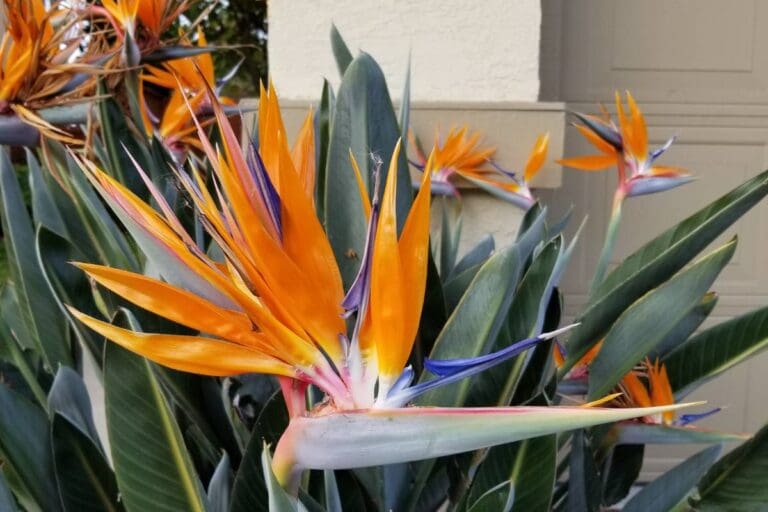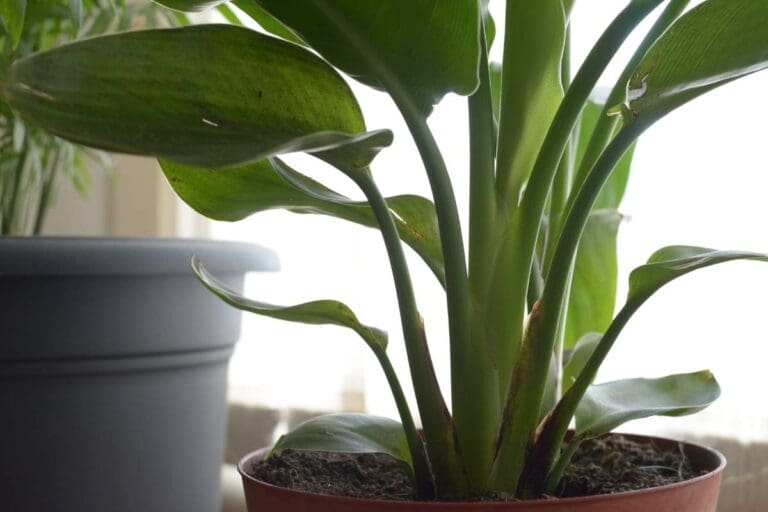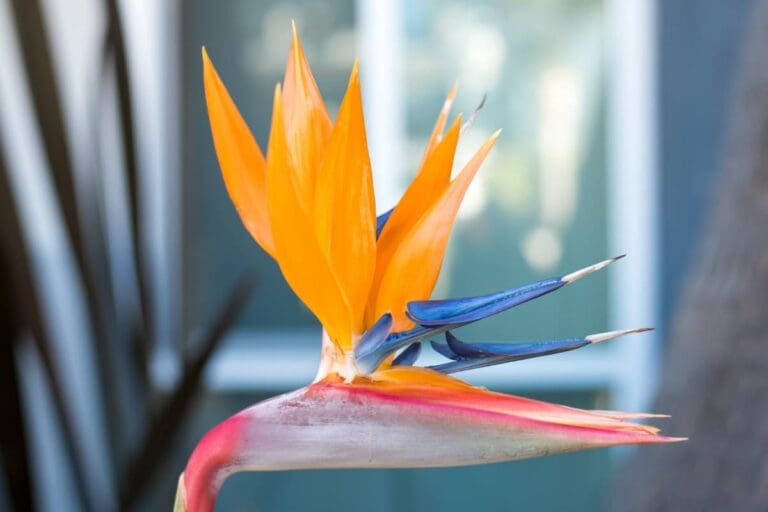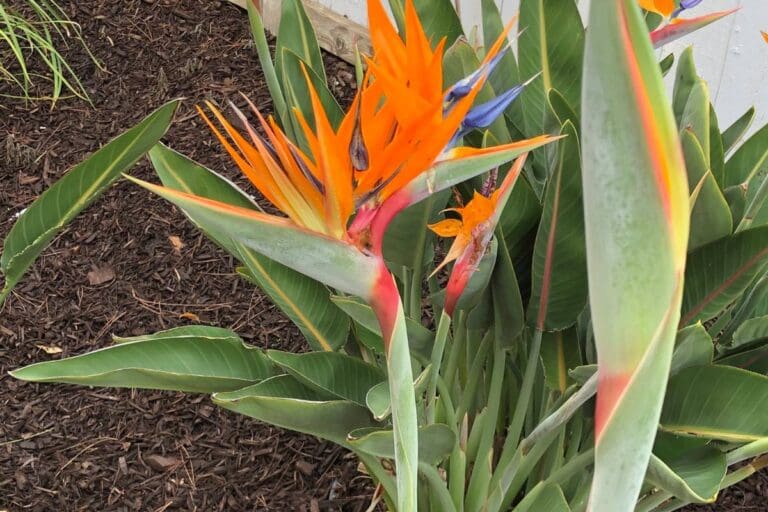Why Is My Bird of Paradise Leaves Not Opening?
The bird of paradise is a lovable houseplant known for their giant, vivid, waxy leaves, but if your bird of paradise leaves are not opening, you should know that there is some problem with the plant.
Lack of sunlight, poor watering, low humidity levels, and pest infestations are some possible problems due to which your bird of paradise leaves is not opening. For the plant to bloom, provide them with bright indirect light, increase humidity, and water the plant before the soil is completely dry.
In this article, we will discuss the reasons that cause your bird of paradise leaves not to open. We will also find out the solutions to fix the same.

Please note: Simplify Plants is reader-supported. Some links in the post are affiliate links and I get a commission from purchases made through links in the post.
Causes of the bird of paradise plant leave not opening:
Seeing the closed leaves on your bird of paradise plant isn’t comforting.
The closed leaves don’t always indicate a serious health problem for your plant.
You can quickly resolve some causes and help your leaves resume their growth.
Let us now discuss some of the most common reasons that cause your bird of paradise leaves not to open.
- Lack of humidity
- Lack of sufficient light
- Poor watering
- Pest infestation
Let us discuss each of the above causes in detail.
1. Lack of humidity
The birds of paradise are tropical plants, so they need a warm and moist environment to grow and thrive.
They constantly need 60-70% humidity to maintain their leaves, especially the new growth.
The humidity levels in homes and offices hardly exceed 40% because of air conditioners, heaters, etc.
When humidity levels are low, the plants transpire at an increasing rate, so the leaves get curled to prevent excess water loss.
Also, the bird of paradise plant stores various secretions and waxes to protect its leaves.
These secretions will get dried if the air is too dry for the plant.
Without these secretions, the plant will fail to open its leaves.
How can I raise the humidity level for my bird of paradise plant?

Some steps can be taken to raise the humidity level around your bird of paradise plant:
- Mist the leaves of your bird of paradise plant with clean water once every week until it starts to unfold its leaves.
- Introduce a humidifier to your plant’s growing space. The device will maintain the ideal humidity levels around your plant. I feel humidifiers are the best way to fix low humidity problems. I use a warm mist humidifier for my bird of paradise plant.
- You can place your plant on pebble trays for a long-term solution. The water from the tray will evaporate and add humidity to the leaves.
- You can also raise humidity by grouping your bird of paradise plant with other tropical plants. All the plants will release moisture through their leaves by transpiration, creating a humid microclimate in the growing area.
2. Lack of sufficient light
Birds of Paradise need a great deal of bright light to grow.
Generally, Birds of paradise need at least 5 to 6 hours of bright indirect light, including some direct light, daily for healthy growth.
Failure to receive the appropriate light will affect the photosynthesis process in plants.
During photosynthesis, the plant converts water, sunlight, and carbon dioxide into energy.
The plant needs this energy to grow new leaves, repair the damaged cells and tissues, and protect itself from pests and diseases.
Therefore, with sufficient light, the plant will unfold its leaves.
What is the ideal place for my bird of paradise plant?

It would help to place your bird of paradise plant in a bright area or near a sunny window where it can get sufficient bright light.
An eastern or western window is ideal for a bird of paradise plant, providing a few hours of direct light daily.
You can use grow or artificial lights if you live in a place lacking natural light.
These affordable lamps will give your plant the light exposure it needs for photosynthesis and getting the energy to grow healthy leaves.
In winter, I use artificial lights for my houseplants when light levels are too low.
3. Poor watering
Water is important for transferring oxygen and nutrients to different plant parts, helping them grow and develop.
The bird of paradise plant usually needs watering once a week during its growing season.
If you don’t water your plant enough, the leaves will appear wavy and refuse to open.
Insufficient moisture will cause the cells to become less turgid or flaccid.
As a result, the plant will not get the internal pressure to maintain its shape, so the leaves will limp, sag, and stay curled.
You are underwatering your bird of paradise if the soil is light, crumbly, and dry.
How to fix the problem of underwatering?

To begin the fixing process, give your bird of paradise a thorough soak in water.
Let us understand the process in detail:
- First, take a large tub and fill it with water halfway up to the pot. Make sure the tub is big enough to accommodate your plant.
- Next, keep your potted plant in the tub for 30-40 minutes. Allow the soil to soak water through the drainage holes present in the pot.
- Once the soil becomes saturated, remove your plant from the tub and allow it to drain the excess water before moving it to its original place.
- Once your plant recovers, water it only after checking the soil moisture level. You can check the soil with your index finger. Water your plant if the top 1-2 inches of soil is dry.
- Follow the deep watering method and water the plant until the excess water drains from the pot’s drainage holes.
4. Pest infestation
The bird of paradise plant leaves that get attacked by pests might not open.
Pests like caterpillars, snails, and slugs will chew the leaves and make holes in them, especially if you have an outdoor bird of paradise.
They will slow down the leaf’s growth, stopping it from opening properly.
Pests like mealybugs, spider mites, and thrips lie on leaves and stems’ backs and suck sap from them.
The sap-sucking insects usually hide inside the closed young leaves, leaving residues that stick to them and preventing them from unfurling.
On the other hand, pests like snails and slugs hide in the soil’s organic matter.
If you notice small bite marks, brown spots, fuzzy patches, or tiny holes, your plant has a pest infestation.
How can I treat pests on my bird of paradise plant?

You can treat pests on your bird of paradise plant by following the measures given below:
- First, inspect your bird of paradise plant by checking leaves and other parts to confirm a pest attack.
- Wash your plant with a steady stream of water to remove some noticeable pests.
- Remove the pest from the leaves by wiping them with cotton balls dipped in isopropyl alcohol.
- Now, fill a spray bottle with Neem oil and spray it on the plant’s leaves, stems, and other parts. Neem oil is one of the best repellents for insect pests. Besides neem oil, I use rosemary, basil, and lavender spray to keep bugs away from my houseplants.
- If your plant has a heavy infestation, use systematic herbicides to deal with the pests. The herbicides are available in granular form and can spread into the soil. The granules will dissolve into the soil when you water the plant. The roots will take up the treated water and transfer the granules to the plant parts, and the pests will die after ingesting the leaves.
Preventing bird of paradise plant leaves from not opening
Some tips which you can follow to prevent the furled leaves of your bird of paradise plant are:
| Factors | Care Requirements |
|---|---|
| Light | Keep your bird of paradise near east or west-facing windows, providing direct and indirect light. Rotate the plant once every week so that all of its sides receive an equal amount of light. Use artificial lights if your plant isn’t getting sufficient natural light. |
| Soil | Grow your bird of paradise plant in a rich, well-drained, slightly acidic, loamy soil. |
| Watering | Check the moisture level of the soil before watering your bird of paradise, and water it only when the top 2 to 3 inches of the soil is dry. |
| Humidity | Try maintaining at least 50% humidity for your bird of paradise plant. Use a humidifier device or pebble trays to add moisture to your plant. Make sure to keep your plant away from air conditioners and heaters. |
| Temperature | For healthy growth, maintain a temperature range of 60-85°F around your bird of paradise plant. Keep the plant away from any cold and hot drafts. |
| Fertilization | Use a balanced organic water-soluble fertilizer for feeding your bird of paradise plant. Apply the fertilizer once every two during the growing season. |
| Pest Prevention | Keep pests and insects away from your bird of paradise plant by spraying it with Neem oil or horticulture oil every month. |
| Pruning | Regularly prune the damaged and dead leaves and other parts of the plant to encourage new healthy growth. |
| Cleaning | Keep the leaves of your plant clean by dusting them regularly. During dusting, check the leaves for any pests. Also, mist the plant leaves every 2-3 days to keep it dirt free. |
Final words
The leaves of your bird of paradise plant can remain folded and not open for several reasons. The most important causes for the leaves of the birds of paradise not opening is low humidity and low light. Lack of water and pest infestations can also make the leaves close.
To open its leaves, you must provide your bird of paradise with bright light, ideal humidity, and proper watering. Applying neem oil sprays every month will keep pests away from your plant. I have explained everything you need to know in-depth in the article.
How long my bird of paradise will take to open its leaves?
The furled leaves of your bird of paradise can take as little as an hour to several days to open, depending on the intensity of the problem. In the case of pest infestation, the furled leaves can take longer to open than the furled leaves due to low humidity problems.
What will happen if I try to open the leaves of my bird of paradise plant manually?
It is never a good idea to manually open your plant’s leaves. It will cause more harm than good to your plant. In general, the younger leaves remain folded, and if you try to open them manually, they can tear as they are very soft and sensitive. The torn leaves will turn brown and stress the plant.
Reference: Wikipedia
Recommended Garden Supplies
| Product Image | Our Recommended Gardening Supplies | Check Offers! |
|---|---|---|
Top Top
Top
Top
Top
Top
Top
Top
Top | rePotme Houseplant and Tropical Classic Potting Soil Mix | Check Offer On Amazon |
 Top
Top
Top
Top
Top
Top
Top
Top | Espoma Organic Indoor Plant Food | Check Offer On Amazon |
 Top
Top
Top
Top
Top
Top
Top
Top | GooingTop LED Grow Light 6000K Full Spectrum Clip Plant Growing Lamp | Check Offer On Amazon |
 Top
Top
Top
Top
Top
Top
Top
Top | Soil Moisture Meter | Check Offer On Amazon |
 Top
Top
Top
Top
Top
Top
Top
Top | Govee Hygrometer Thermometer, Bluetooth Enabled! | Check Offer On Amazon |
 Top
Top | LEVOIT Humidifiers for Large Room(Best For Plants) | Check Offer On Amazon |
 Top
Top
Top
Top
Top
Top
Top
Top | Upgraded DIY Automatic Drip Irrigation Kit, 15 Potted Houseplants Support | Check Offer On Amazon |
 Top
Top
Top
Top
Top
Top
Top
Top | Stainless Steel Heavy Duty Gardening Tool Set | Check Offer On Amazon |
 Top
Top
Top
Top
Top
Top
Top
Top | Bonide Insecticidal Soap | Check Offer On Amazon |
 Top
Top
Top
Top
Top
Top
Top
Top | Bonide 32 oz Spray Neem Oil for Organic Gardening | Check Offer On Amazon |
 Top
Top
Top
Top
Top
Top
Top
Top | Garden Safe Fungicide | Check Offer On Amazon |






Its excellent as your other articles : D, thanks for putting up.